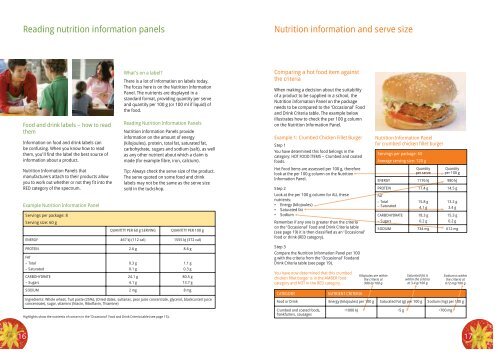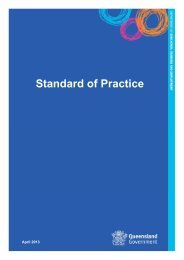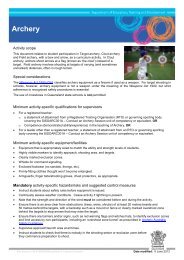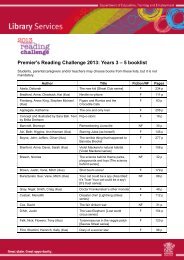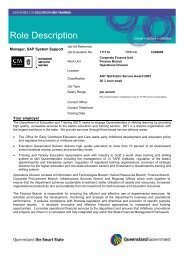Smart Choices - Healthy Food and Drink Supply Strategy for ...
Smart Choices - Healthy Food and Drink Supply Strategy for ...
Smart Choices - Healthy Food and Drink Supply Strategy for ...
Create successful ePaper yourself
Turn your PDF publications into a flip-book with our unique Google optimized e-Paper software.
Reading nutrition in<strong>for</strong>mation panels<br />
<strong>Food</strong> <strong>and</strong> drink labels – how to read<br />
them<br />
In<strong>for</strong>mation on food <strong>and</strong> drink labels can<br />
be confusing. When you know how to read<br />
them, you’ll find the label the best source of<br />
in<strong>for</strong>mation about a product.<br />
Nutrition In<strong>for</strong>mation Panels that<br />
manufacturers attach to their products allow<br />
you to work out whether or not they fit into the<br />
RED category of the spectrum.<br />
Example Nutrition In<strong>for</strong>mation Panel<br />
Servings per package: 8<br />
Serving size: 60 g<br />
What’s on a label?<br />
There is a lot of in<strong>for</strong>mation on labels today.<br />
The focus here is on the Nutrition In<strong>for</strong>mation<br />
Panel. The nutrients are displayed in a<br />
st<strong>and</strong>ard <strong>for</strong>mat, providing quantity per serve<br />
<strong>and</strong> quantity per 100 g (or 100 ml if liquid) of<br />
the food.<br />
Reading Nutrition In<strong>for</strong>mation Panels<br />
Nutrition In<strong>for</strong>mation Panels provide<br />
in<strong>for</strong>mation on the amount of energy<br />
(kilojoules), protein, total fat, saturated fat,<br />
carbohydrate, sugars <strong>and</strong> sodium (salt), as well<br />
as any other nutrient about which a claim is<br />
made (<strong>for</strong> example fibre, iron, calcium).<br />
Tip: Always check the serve size of the product.<br />
The serve quoted on some food <strong>and</strong> drink<br />
labels may not be the same as the serve size<br />
sold in the tuckshop.<br />
QUANTITY PER 60 g SERVING QUANTITY PER 100 g<br />
ENERGY 467 kJ (112 cal) 1555 kJ (372 cal)<br />
PROTEIN 2.6 g 8.6 g<br />
FAT<br />
– Total<br />
0.3 g<br />
1.1 g<br />
– Saturated<br />
0.1 g<br />
0.3 g<br />
CARBOHYDRATE<br />
24.1 g<br />
80.5 g<br />
– Sugars<br />
4.1 g<br />
13.7 g<br />
SODIUM 2 mg 8 mg<br />
Ingredients: Whole wheat, fruit paste (25%), (Dried dates, sultanas, pear juice concentrate, glycerol, blackcurrant juice<br />
concentrate), sugar, vitamins (Niacin, Riboflavin, Thiamine)<br />
Highlights show the nutrients of concern in the ‘Occasional’ <strong>Food</strong> <strong>and</strong> <strong>Drink</strong> Criteria table (see page 15).<br />
Nutrition in<strong>for</strong>mation <strong>and</strong> serve size<br />
Comparing a hot food item against<br />
the criteria<br />
When making a decision about the suitability<br />
of a product to be supplied in a school, the<br />
Nutrition In<strong>for</strong>mation Panel on the package<br />
needs to be compared to the ‘Occasional’ <strong>Food</strong><br />
<strong>and</strong> <strong>Drink</strong> Criteria table. The example below<br />
illustrates how to check the per 100 g column<br />
on the Nutrition In<strong>for</strong>mation Panel.<br />
Example 1: Crumbed Chicken Fillet Burger<br />
Step 1<br />
You have determined this food belongs in the<br />
category: HOT FOOD ITEMS – Crumbed <strong>and</strong> coated<br />
foods.<br />
Hot <strong>Food</strong> Items are assessed per 100 g, there<strong>for</strong>e<br />
look at the per 100 g column on the Nutrition<br />
In<strong>for</strong>mation Panel.<br />
Step 2<br />
Look at the per 100 g column <strong>for</strong> ALL these<br />
nutrients:<br />
Energy (kilojoules)<br />
Saturated fat<br />
Sodium<br />
Remember if any one is greater than the criteria<br />
on the ‘Occasional’ <strong>Food</strong> <strong>and</strong> <strong>Drink</strong> Criteria table<br />
(see page 19) it is then classified as an ‘Occasional’<br />
food or drink (RED category).<br />
Step 3<br />
Compare the Nutrition In<strong>for</strong>mation Panel per 100<br />
g with the criteria from the ‘Occasional’ <strong>Food</strong><strong>and</strong><br />
<strong>Drink</strong> Criteria table (see page 19).<br />
You have now determined that this crumbed<br />
chicken fillet burger is in the AMBER food<br />
category <strong>and</strong> NOT in the RED category.<br />
CATEGORY NUTRIENT CRITERIA<br />
<strong>Food</strong> or <strong>Drink</strong> Energy (kilojoules) per 100 g Saturated Fat (g) per 100 g Sodium (mg) per 100 g<br />
Crumbed <strong>and</strong> coated foods,<br />
frankfurters, sausages<br />
Kilojoules are within<br />
the criteria at<br />
980 kJ/100 g<br />
Nutrition In<strong>for</strong>mation Panel<br />
<strong>for</strong> crumbed chicken fillet burger<br />
Servings per package: 60<br />
Average serving size: 120 g<br />
Quantity Quantity<br />
per serve per 100 g<br />
ENERGY 1176 kJ 980 kJ<br />
PROTEIN<br />
FAT<br />
17.4 g 14.5 g<br />
– Total<br />
15.8 g<br />
13.2 g<br />
– Saturated<br />
4.1 g<br />
3.4 g<br />
CARBOHYDRATE 18.3 g<br />
15.3 g<br />
– Sugars<br />
0.2 g<br />
0.2 g<br />
SODIUM 734 mg 612 mg<br />
Saturated fat is<br />
within the criteria<br />
at 3.4 g/100 g<br />
>1000 kJ >5 g >700 mg<br />
Sodium is within<br />
the criteria at<br />
612 mg/100 g<br />
16 17


